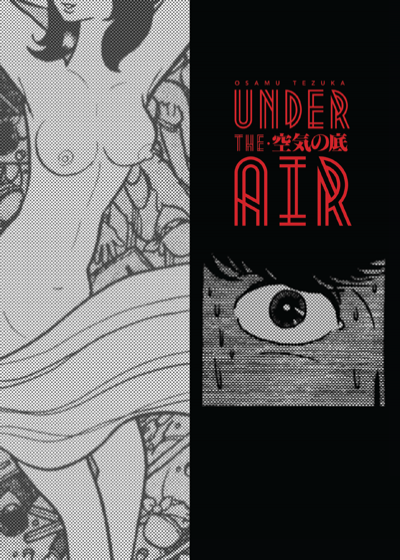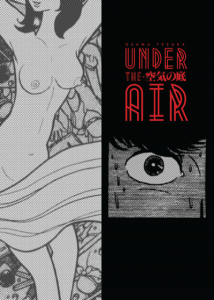By Osamu Tezuka. Released in Japan by Akita Shoten, serialized in the magazine Play Comic. Released in North America by Digital Manga Publishing. Translated by Grady Martin. Adapted by Nate Heneghan.
One of the difficulties in reading the so-called God of Manga is that there is a certain tendency to try to see everything as a masterwork. This can be quite difficult with Tezuka, who has written SO MUCH already. But just as there is good Tezuka, there is also bad Tezuka. And there is also Tezuka feeling things out, trying to grow and learn and make the manga industry grow and learn with him. Under the Air is one of those types. Created for the more mature Play Magazine, it’s a series of unrelated short stories – unrelated except for an interconnected theme of good and evil. As an experimental collection, it’s very hit-or-miss in terms of enjoyment. As a document of Tezuka, I found it far more interesting, and you can also see how it improves as it goes along – my favorite story was Under the Air itself, which is the final one in the volume.
Yes, as the cover art indicates, this is definitely one of Tezuka’s work for adults. There’s violence, murder, racism, death, sex, incest, and all sorts of human frailties along the way. The manga has a high bar to clear – because it’s meant to be about the nature of evil in many ways, its protagonists tend to be horrible people. Frequently his goal is to show them have some sort of revelatory experience that leads, if not to a change of heart, then at least to a changed state. At the start, this doesn’t work out so well – the star of Joe’s Visitor is SUCH a loathsome human being that there is absolutely no way I bought him returning at the end – in fact, I was initially baffled as to what was happening. A couple of the stories also “star” Tezuka as himself, usually looking for story ideas or visiting friends, and running into trouble. Tezuka, amusingly, does not portray himself in a very likeable way either, though he’s certainly more likeable than a lot of these people.
As the volume goes on, the stories get a bit more ‘fantastical’ in nature, ranging from hallucinatory images to experimental drugs to swapping your wife’s mind with that of a donkey – yes, really. You can also see Tezuka getting a handle on what he’s actually trying to do – the characters are not as “bwahaha, I am a BAD PERSON!” as they were at the start, and therefore the moral of whatever story he’s telling makes more sense and flows better. This culminates in the final story, featuring two innocents raised by themselves in a spaceship-style environment who grow up and become curious about the world outside their little bubble – which shows off the fact that good innocence can lead to just as many tragic consequence as evil heartlessness, though the story ends on a bittersweet rather than bitter note.
This volume came out via Digital Manga Publishing’s Kickstarter efforts, and there is theoretically a lot more coming in the near future. Under the Air is never going to be placed up there with the best mature Tezuka titles such as MW or Ode to Kirihito. But it’s an excellent example of seeing Tezuka experiment, sometimes fail, sometimes succeed, and push boundaries as far as he thinks he can take them.


I definitely agree of this as being more of a “document of Tezuka”. I think a lot of his short story collections seem to fall into this. Actually, a lot of his stuff seems to, just in general. Sure, we get epics like Buddha, but it seems like he didn’t actually make a lot of long-form stories, come to think of it. It’s like he typically tended to get bored after 3-4 volumes and just rush ended things constantly (see Dororo, Princess Knight, the list goes on). And even things like Black Jack or Astro Boy are short story format (Astro Boy did have a few longer arcs, but it still seemed 3 vols was the max on those). Even his completed mature stories (like MW or Kirhito) still ended in 3-4 vols, but at least it feels like he planned to end them there instead of getting bored and calling it off to move onto some other new shiny thing. But even though he clearly got distracted, I still tend to enjoy the short story collections anyway somehow.
Still, I can definitely respect his eagerness to try new things. I doubt we could’ve gotten the amazing Phoenix chapter of Sun without it. But there’s definitely a reason that Phoenix endured while his short story collections seemed to fall by the wayside. And a lot of his early works have also been forgotten, which, from what I’ve read of them, have been generally pretty universally terrible. But I still have them due to the collector in me.
I think I still need to read Record of the Glass Castle from this DMP Tezuka set, I was kind of hoping that the 8 books from the Wonder 3 Kickstarter would be in by now and was trying to space out the ones I had from last time, but guess I caught up a bit too quickly after all. Just wish we got another update, it’s been about 3 months since the last update.
Nice to see a write up on a classic title, it’s a very fair review. I like Under the Air since it shows the foundation for some ideas that Tezuka later expanded on in other titles. One of the stories here “The Voice of Night” received a short live-action special last year in Japan too. Though, I am partial to the original story before Tezuka changed it a little to avoid a sensitive issue around Burakumin. All in all I’m glad DMP did manage to bring Under the Air out.
I’m curious when you or others received a copy? DMP started shipping them out in July but I didn’t get my package until October and it’s my understanding some backers are still waiting or had missing/incorrect items. Physical copies aren’t up for sale generally yet either. So it’s hard to recommend Under the Air or the other books (so many late Kickstarter projects and poor communication) since people are wishing to get them in print.
Hi Sean,
This is a nice piece.
Have you seen my post about the chronology and various editions?
I won’t link it here, for the sake of etiquette. If you’re interested, it’s on my Twitter TL.
The main thing I want to say is that the first book edition is special.
Here is the table of contents:
Vol. 1
3-Dec-1971
Joe’s Visitor
The Voice of Night
The Cliff of Death
Cape Uroko (Scales)
Illicit Love
Valley of Bliss
Telephone
Sack (10 May 1968 issue of Manga Sunday magazine, extra issue) (In English in ‘Clockwork Apple’)
Night on the Bypass (10 October 1969 issue of Shukan Post magazine) (In English in ‘Clockwork Apple’)
The Cat’s Blood
Vol. 2
15 Feb 1972
The Execution Ended at Three O’Clock (In English in ‘Clockwork Apple’)
Masterless Samurai (February 1970 issue of Sunday Mainichi Yomimono Senka) (Kodansha 400 Vol. 239 ‘Short Arabesque’)
Miraculous Conception (In English in ‘Clockwork Apple’)
Blood Suckers (Kodansha 400 Vol. 239 ‘Short Arabesque’)
Catastrophe in the Dark
The Octopus’ Legs (April 1970 issue of Shosetsu Sunday Mainichi magazine) (Kodansha 400 Vol. 239 ‘Short Arabesque’)
The Deep Cave (6 Nov 1970 issue of Sunday Mainichi magazine, extra issue) (not published in any other anthology)
Rovanna/Oh, Robanna!
Lovers under the Air
This is the most potent edition of ‘Under the Air’.
It’s fun to examine it for clues about Osamu Tezuka’s thought process.
It’s also enjoyable figuring out why none of the books compile the stories in chronological order of magazine appearance.
That’s all for now. Cheers~
Under the Air chronology and publication spreadsheet https://docs.google.com/spreadsheets/d/1zDujqD7WEk9QzLoiX81oB6xjmAuZ8zCOl_7zVGQHNdU/edit#gid=0